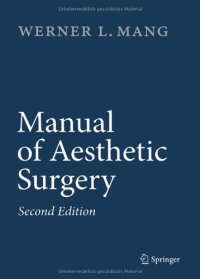
Ebook: Manual of Aesthetic Surgery
- Tags: Plastic Surgery, Dermatology, Otorhinolaryngology, Oral and Maxillofacial Surgery, Head and Neck Surgery
- Year: 2010
- Publisher: Springer-Verlag Berlin Heidelberg
- Edition: 2
- Language: English
- pdf
At the request of Springer-Verlag, Heidelberg, I have written with pride and pleasure the new edition of the Manual of Aesthetic Surgery. Volumes1(headand neckregion)and 2(body)havebeen integrated into one volume, which has been revised and extended with the addition of the topics “Cosmetic Aesthetic Surgery,” “Breast Surgery,” “Mini Lift,” “Mini Abdomen,” “Buttock Lift,” and “Tumescence Li- suction with the MicroAire® System.” The current trend is towards gentle surgical methods. The ‘Mang School’ has as its motto: Less is more! You should not see cosmetic s- gery. Aesthetic surgery is feel-good surgery and not altering surgery. That should be the philosophy of this book. The first editions of both volumes of the Manual of Aesthetic Surgery had high print runs and were translated into many languages, including Spanish, Russian, and Chinese. The new edition bridges a few gaps, namely breast lifting and breast reduction. These operations are described in detail using illustrations and videos, in order to provide also plastic and aesthetic surgeons with standards. Standards are of crucial importance in aesthetic surgery. Results must be reproducible. Every aesthetic surgeon will then be able to build on this manual and refine his or her methods.
This second edition of the highly acclaimed Manual of Aesthetic Surgery again focuses on the most important and most frequently used procedures in aesthetic surgery. All chapters have been updated, and useful tips and tricks have been added. A number of important new methods are included, such as a facial mini lift (M-lift), a mini abdomen procedure, a so-called de-epithelializing method for use in buttock lifts, and liposuction by means of a sophisticated Micro-Air system. All techniques are displayed in a step-by-step manner with unsurpassed instructive drawings and high-quality pre- and postoperative photographs; only as much text is included as is absolutely necessary to support the illustrations. The accompanying DVD has been enhanced by additional new clips. Using the book and the DVD in conjunction, the reader will be able to identify and execute the most appropriate technique in each situation, avoid potential pitfalls, and institute appropriate complication management should it prove necessary.